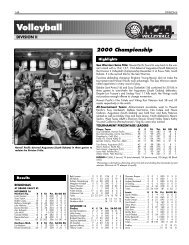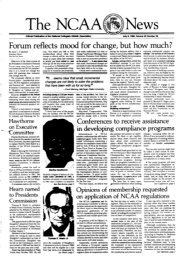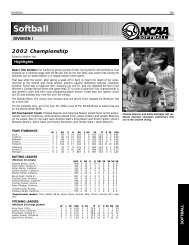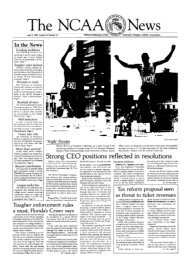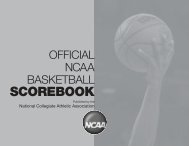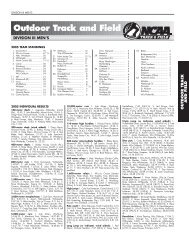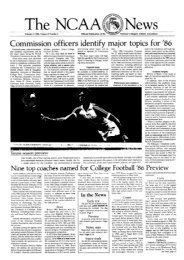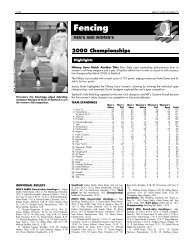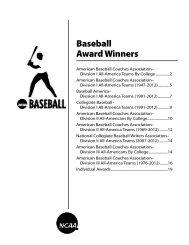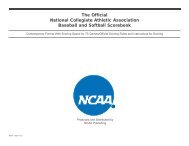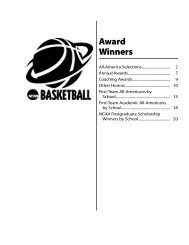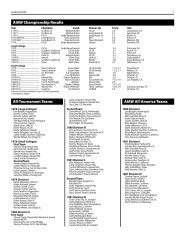Sports Medicine Handbook - NCAA
Sports Medicine Handbook - NCAA
Sports Medicine Handbook - NCAA
You also want an ePaper? Increase the reach of your titles
YUMPU automatically turns print PDFs into web optimized ePapers that Google loves.
Guidelines for Helmet<br />
Fitting and Removal<br />
in Athletics<br />
June 1990 • Revised June 2006<br />
Several sports, including football,<br />
men’s lacrosse and ice hockey,<br />
require wearing tight-fitting,<br />
similarly constructed helmets. The<br />
following guidelines, while focused<br />
on football, are applicable to<br />
periodic evaluation, fitting and<br />
removal of protective helmets worn<br />
in any sport. These guidelines<br />
represent minimal standards of care<br />
that are designed to assist<br />
physicians, coaches, athletic<br />
trainers, paramedics, EMTs and<br />
hospital personnel who care for<br />
student-athletes.<br />
Medical coverage of interscholastic<br />
and intercollegiate teams entails<br />
many routine preventive and acute<br />
health-care duties for dedicated<br />
practicing professionals; how ever,<br />
an occasional, serious, on-the-field,<br />
life-threatening head and/or neck<br />
injury poses a difficult challenge. It<br />
is incumbent upon those<br />
individuals assigned to provide<br />
medical coverage to be prepared to<br />
handle each situation efficiently<br />
and expertly.<br />
Proper on-the-field management of<br />
head and neck injuries is essential<br />
to minimize sequelae, expedite<br />
emergency measures and to prepare<br />
for transportation. The action of<br />
those in attendance must not<br />
compound the problem. For this<br />
reason, clear communication<br />
GUIDELINE 3e<br />
between the medical staff and<br />
emergency-transportation personnel<br />
should be maintained. It is<br />
important that those involved in the<br />
medical management of teams<br />
engaged in collision and contact<br />
sports, and the student-athlete be<br />
knowledgeable about the helmet.<br />
The student-athlete should be<br />
instructed in the fitting, care and<br />
use of the helmet. Helmet<br />
manufacturer guidelines should be<br />
reviewed and followed for proper<br />
fitting and care techniques.<br />
The resilient plastic shell is shaped<br />
spherically to deflect impacts.<br />
In terior suspension pads are<br />
designed to match the skull contour<br />
to ensure a snug crown fit. Various<br />
rigid and removable jaw and brow<br />
pads, along with the chin strap,<br />
help to hold the sides of the helmet<br />
firmly against the mandible and the<br />
forehead. When in place, the front<br />
edge of the helmet should be<br />
positioned about a finger’s breadth<br />
above the eyebrows. Pressure on<br />
the helmet crown should be<br />
dissipated through the interior<br />
suspension padding over the top of<br />
the head.<br />
The helmet should fit snugly<br />
without dependence on the chin<br />
strap. The helmet should not twist<br />
or slide when an examiner grasps<br />
the face mask and attempts to rock<br />
or turn the helmet with the wearer<br />
resisting the movement.<br />
With a properly fitted helmet, the<br />
top of the head is separated from<br />
the helmet shell by a uniform,<br />
functional, shock-absorbing<br />
support lining. Daily evaluation of<br />
this support mechanism, including<br />
cheek and brow pads, for<br />
placement and resiliency should be<br />
taught to the student-athlete. Helmets<br />
that require air inflation<br />
should be inflated and inspected<br />
daily by the student-athlete. Helmet<br />
shells should be examined weekly<br />
for cracking and be inspected<br />
closely again if the face mask has<br />
been bent out of shape. All helmets<br />
need to be reconditioned and the<br />
attachments of the mask replaced<br />
on a yearly basis.<br />
Although the helmet is designed<br />
for a stable fit for protection during<br />
play, removal of the helmet by<br />
others is relatively difficult. In the<br />
case of a head or neck injury,<br />
jostling and pulling during removal<br />
presents high potential for further<br />
trauma.<br />
Unless there are special<br />
circumstances such as<br />
respiratory distress coupled with<br />
an inability to access the airway,<br />
the helmet should never be<br />
removed during the pre-hospital<br />
101



